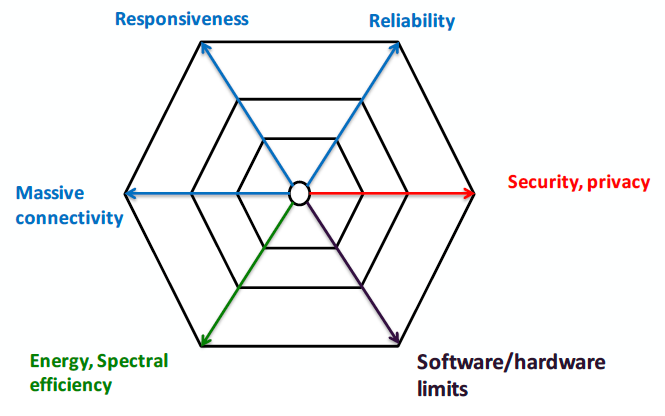Section: Research Program
General description
As presented in the first section, Computing Networks is a concept generalizing the study of multi-user systems under the communication perspective. This problematic is partly addressed in the aforementioned references. Optimizing Computing Networks relies on exploiting simultaneously multi-user communication capabilities, in the one hand, and storage and computing resources in the other hand. Such optimization needs to cope with various constraints such as energy efficiency or energy harvesting, delays, reliability or network load.
The notion of reliability (used in MARACAS acronym) is central when considered in the most general sense : ultimately, the reliability of a Computing Network measures its capability to perform its intended role under some confidence interval. Figure 1 represents the most important performance criteria to be considered to achieve reliable communications. These metrics fit with those considered in 5G and beyond technologies [63].
On the theoretical side, multi-user information theory is a keystone element. It is worth noting that classical information theory focuses on the power-bandwith tradeoff usually referred as Energy Efficiency-Spectral Efficiency (EE-SE) tradeoff (green arrow on 1). However, the other constraints can be efficiently introduced by using a non-asymptotic formulation of the fundamental limits [62], [64] and in association with other tools devoted to the analysis of random processes (queuing theory, ...).
Maracas aims at studying Computing Networks from a communication point of view, using the foundations of information theory in association with other theoretical tools related to estimation theory and probability theory.
In particular, Maracas combines techniques from communication and information theory with statistical signal processing, control theory, and game theory. Wireless networks is the emblematic application for Maracas, but other scenarios are appealing for us, such as molecular communications, smart grids or smart buildings.
Several teams at Inria are addressing computing networks, but working on this problem with an emphasis on communication aspects is unique within Inria.
The complexity of Computing Networks comes first from the high dimensionality of the problem: i) thousands of nodes, each with up to tens setting parameters and ii) tens variable objective functions to be minimized/maximized.
In addition, the necessary decentralization of the decision process, the non stationary behavior of the network itself (mobility, ON/OFF Switching) and of the data flows, and the necessary reduction of costly feedback and signaling (channel estimation, topology discovering, medium access policies...) are additional features that increase the problem complexity.
The original positioning of Maracas holds in his capability to address three complementary challenges :



